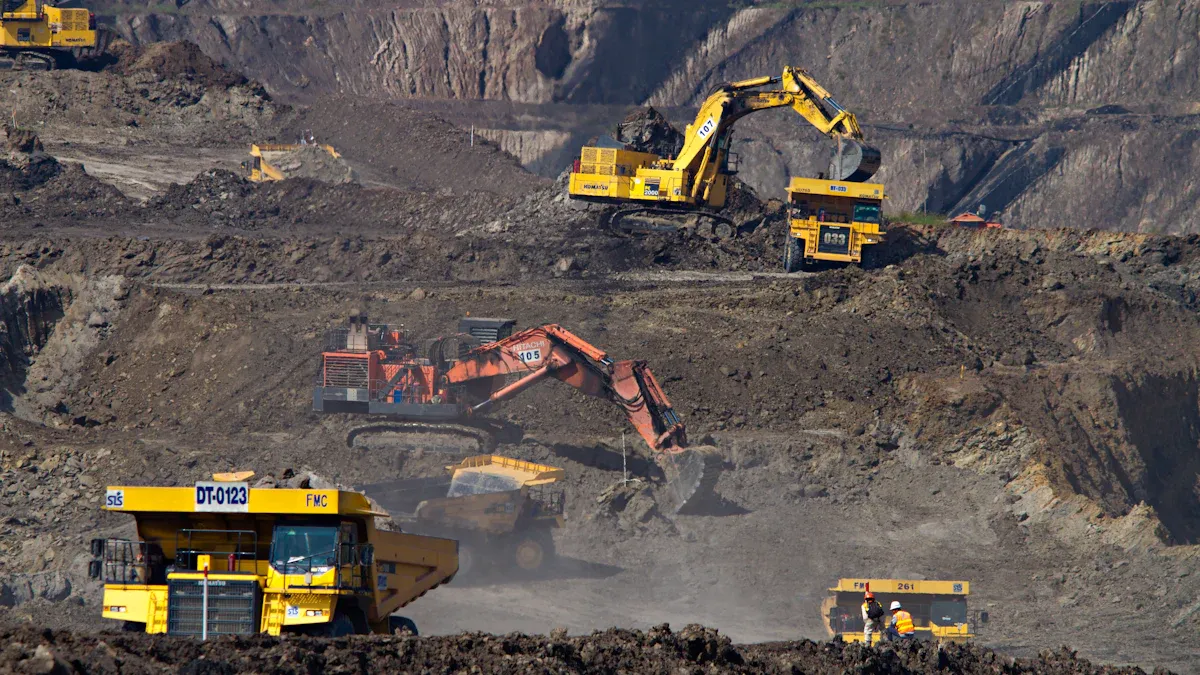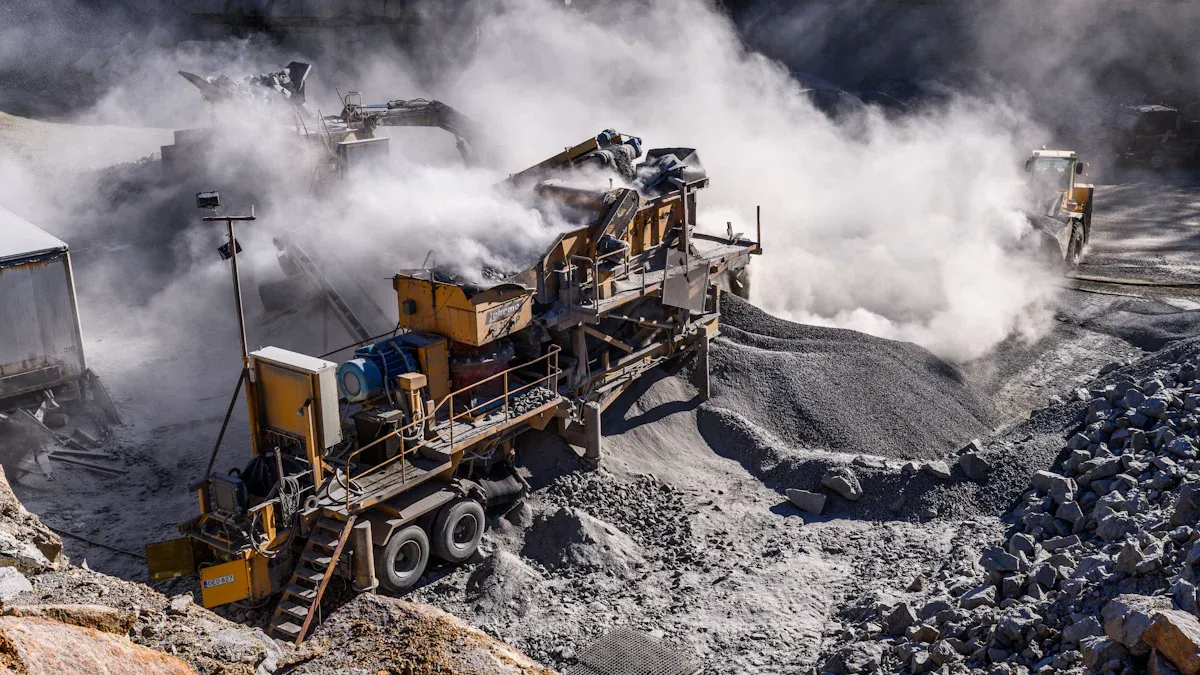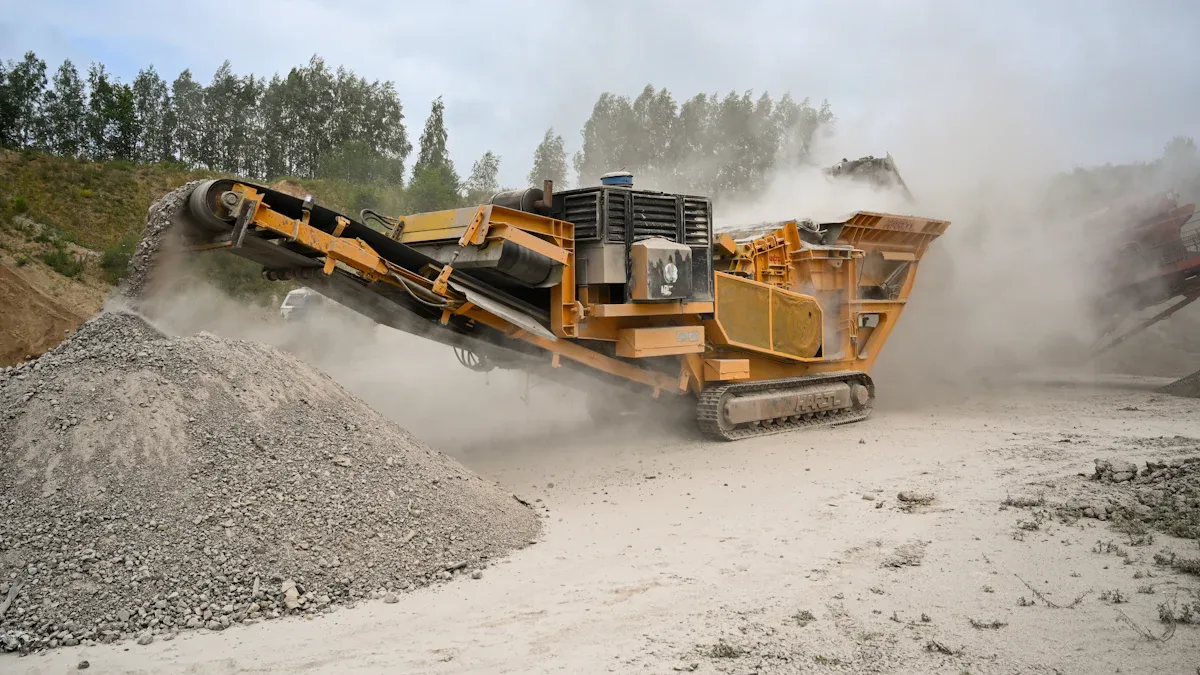
In mining, you face some of the harshest working conditions imaginable. Equipment must endure constant abrasion and high-impact force s. Chromium cast iron wear parts play a critical role in meeting these demands. Their exceptional wear resistance ensures that mining tools last longer, even in abrasive environments. High-chromium cast irons offer unmatched durability, reducing the frequency of equipment failures. By minimizing downtime and operational costs, they help you achieve greater efficiency. These materials are indispensable for maintaining reliable performance in the tough world of mining.

Mining operations expose equipment to extreme conditions, including abrasive wear and high-impact forces. High-chromium cast irons excel in these environments due to their exceptional wear resistance. These materials contain a high percentage of chromium, which forms hard carbides that resist abrasion. This unique property allows mining tools to maintain their structural integrity even when handling tough materials like ore and rock.
You benefit from this superior wear resistance by reducing the frequency of part replacements. For example, crushers and grinding mills equipped with high-chromium cast irons can process more material before showing signs of wear. This durability ensures that your equipment operates efficiently, minimizing interruptions caused by maintenance.
High-chromium cast irons significantly extend the lifespan of mining equipment. Their ability to withstand both abrasive and erosive wear ensures that critical components remain functional for longer periods. Studies comparing traditional high-chromium cast iron (HCCI) to rare-earth-modified HCCI highlight this improvement.
| Metric | Traditional HCCI | RE-Modified HCCI | Improvement |
|---|---|---|---|
| Wear Resistance | 1.0× | 1.1–1.8× | ↑ 10–80% |
| Hardness (HRC) | 58–62 | 62–67 | ↑ 7–8% |
| Impact Toughness (J/cm²) | 4–6 | 8–12 | ↑ 67–100% |
| Service Life (hours) | 800–1,000 | 2,000–2,600 | ↑ 150–225% |
This data demonstrates how high-chromium cast irons improve durability across multiple metrics. By using these materials, you can double or even triple the service life of your equipment. This longevity reduces the need for frequent replacements, saving you time and resources.
Investing in high-chromium cast irons offers long-term financial benefits. These materials reduce operational costs by extending the lifespan of wear parts and minimizing downtime. For instance, high-chromium cast iron wear parts account for only 18% of operational expenses in mining. Additionally, hybrid tungsten-carbide composites can extend part lifetimes by 40–60%, further enhancing cost efficiency.
| Evidence Type | Description |
|---|---|
| Operational Savings | High chromium cast iron wear parts account f or 18% of operational expenses. |
| Cost Penalties | Chromium steel castings face 8–11% cost penalties in carbon-regulated markets. |
| Market Dynamics | Advanced materials are reshaping the competitive landscape. |
While there are cost penalties in certain markets, the overall savings from reduced maintenance and extended equipment life outweigh these challenges. By choosing high-chromium cast irons, you optimize your mining operations for both performance and profita bility.
High-chromium cast irons play a vital role in mining by enhancing the performance of critical equipment. Their exceptional wear resistance and durability make them ideal for handling abrasive wear and erosive wear in challenging environments. Below are some key applications where these materials excel.
Crushers and grinding mills face constant exposure to abrasive materials like ore and rock. High-chromium cast irons improve the durability of these machines by resisting wear and maintaining their structural integrity. The hard carbides in these materials provide superior abrasion resistance, ensuring that the parts last longer. This reduces the frequency of replacements and keeps your equipment running efficiently.
For example, liners and hammers made from high-chromium cast irons can withstand the high-impact forces in crushers. Similarly, grinding mill components like balls and rollers benefit from the material's wear resistance. By using these wear parts, you can process more material with fewer interruptions, saving time and resources.
Excavators and haul trucks operate in some of the harshest conditions in mining. High-chromium cast irons enhance the durability of components like buckets, teeth, and wear plates. These parts often encounter abrasive wear and erosive wear from handling heavy loads of rock and ore.
< p>The corrosion resistance of high-chromium cast irons also protects these components from environmental damage. This ensures that your equipment remains reliable even in wet or chemically aggressive conditions. By investing in high-quality materials, you can extend the service life of your excavation and hauling equipment, reducing maintenance costs.
Screening and sorting machinery relies on wear-resistant components to handle the constant flow of abrasive materials. High-chromium cast irons are ideal for screens, grates, and other wear applications in these machines. Their abrasion resistance ensures that these parts can endure prolonged use without significant wear.
Additionally, the corrosion resistance of high-chromium cast irons prevents damage from moisture and other environmental factors. This improves the overall efficiency of your screening and sorting operations. By choosing high-chromium cast irons, you can maintain consistent performance and reduce downtime caused by part failures.

The chromium content in high-chromium cast irons plays a crucial role in their performance. Chromium forms hard carbides within the material, which significantly enhances wear resistance. These carbides act as a protective barrier, reducing the effects of abrasion and extending the durability of the parts.
Heat treatment further improves the properties of high-chromium cast irons. For example, as-cast components typically have lower wear resistance and hardness. However, heat-treated parts show a marked improvement in both metrics. Tempering these materials can increase wear resistance even further, although it slightly reduces hardness.
| Tre atment | Wear Resistance | Hardness |
|---|---|---|
| As-cast | Low | Low |
| Heat-treated | High | High |
| Tempered | Higher than heat-treated | Lower than heat-treated |
Research also highlights the importance of chromium's interaction with other elements. Studies show that a multiphase matrix, created by varying chromium and carbon content, enhances wear resistance compared to a fully ferritic matrix. This combination ensures that high-chromium cast irons perform exceptionally well in mining applications, where abrasion resistance is critical.
| Study | Findings |
|---|---|
| Scandian et al. | A multiphase matrix improves wear resistance compared to a ferritic one. |
| Fernández et al. | Plasti c deformation leads to cracks and fragmentation in cast irons. |
The microstructure of high-chromium cast irons directly infl uences their performance. These materials contain eutectic carbides, which are extremely hard and resistant to wear. The carbides are evenly distributed throughout the material, providing consistent protection against abrasion.
Hardness is another key factor. High-chromium cast irons typically achieve hardness levels between 58 and 67 HRC, depending on their treatment. This hardness allows the material to withstand the constant impact and abrasion found in min ing environments. The combination of a robust microstructure and high hardness ensures that these parts maintain their durability over extended periods.
You benef it from this unique composition because it minimizes the risk of premature failure. Whether you're using crushers, grinding mills, or excavation equipment, the carbide microstructure ensures that your tools can handle the toughest conditions.
High-chromium cast irons excel in abrasive and high-impact environments, making them ideal for mining applications. Their wear resistance stems from the presence of hard carbides and a carefully engineered microstructure. Performance tests confirm that these materials can endure extreme conditions without significant wear.
The chemical composition of high-chromium cast irons plays a vital role in their effectiveness. Alloys with a higher Cr/C ratio demonstrate better resistance to abrasive weight loss. This means that the material can handle prolonged exposure to abrasive forces, such as those encountered in ore processing.
Durability is another standout feature. High-chromium cast irons resist not only abrasion but also corrosion, ensuring reliable performance in wet or chemically aggressive environments. This dual resistance makes them a versatile choice for mining operations. By choosing high-chromium cast irons, you ensure that your equipment remains opera tional for longer, reducing downtime and maintenance costs.
When comparing high-chromium cast irons to manganese steel, you’ll notice significant differences in performance. High-chromium cast irons excel in wear resistance due to their carbide microstructure. These carbides act as a shield, reducing abrasion and extending the lifespan of wear parts. Mangane se steel, while known for its toughness, lacks the same level of abrasion resistance.
In mining, where equipment faces constant exposure to abrasive materials, high-chromium cast irons outperform manganese steel. For example, studies show that high-chromium cast irons experience less abrasive wear than Hadfield steel, a common manganese alloy. This makes them a better choice for crushers, grinding mills, and other high-impact applications. By choosing high-chromium cast irons, you reduce maintenance needs and improve equipment durability. < /p>
Ceramic wear parts offer excellent hardness and corrosion resistance, but they fall short in high-impact environments. High-chromium cast irons provide a balanced solution, combining wear resistance with impact toughness. This makes them more ve rsatile for mining operations.
For instance, ceramic parts may crack or shatter under heavy loads, while high-chromium cast irons maintain their structural integrity. Research highlights the superior performance of high-chromium cast irons in abrasive conditions, especially when heat-treated. Their ability to resist both abrasion and corrosion ensures reliable performance in harsh environments.
| Study | Material | Key Findings |
|---|---|---|
| Effect of Cr/C Ratio and Heat Treatment | High Chromium Cast Iron | Improved wear resistance with increased manganese content; optimal performance at 3% Mn. |
| Abrasive Wear Behavior Comparison | High Chromium Cast Iron vs Hadfield Steel | High chromium cast iron shows lower abrasive wear compared to Hadfield steel due to carbide presence. |
By choosing high-chromium cast irons, you gain a material that withstands both abrasion and impact, ensuring long-term durability.
High-chromium cast irons offer an excellent balance between cost and performance. While their initial cost may be higher than manganese steel or ceramic parts, their extended service life offsets this expense. You save money by reducing the frequency of replacements and minimizing downtime.
For example, hybrid tungsten-carbide composites can extend part lifetimes by 40–60%. High-chromium cast irons also resist corrosion, further enhancing their value in mining environments. This dual resistance to wear and corrosion ensures that your investment pa ys off over time.
When you consider the total cost of ownership, high-chromium cast irons emerge as a cost-effective choice. Their durability and wear resistance make them indispensable for mining operations aiming to optimize efficiency and profitability.
To maximize the lifespan of chromium cast iron wear parts, you should adopt industry best practices. These strategies not only enhance durability but also promote sustainability in mining operations:
Use advanced manufacturing techniques to improve material strength and wear resistance.
Implement recycling initiatives to reduce reliance on virgin materials, cutting energy consumption by up to 70%.
Transition to non-toxic production alternatives to minimize hazardous waste.
Employ innovative cooling and cleaning methods to recycle water, reducing water usage by up to 50%.
Integrate renewable energy sources into operations to lower carbon emissions by over 30%.
By following these practices, you can ensure that your wear parts perform efficiently while contributing to environmentally responsible mining.
Regular inspection of chromium cast iron wear parts is essential for maintaining optimal performance. Look for signs of wear, such as thinning, cracks, or pitting. Replace parts before they fail to avoid costly downtime.
When replacing components, ensure compatibility with your equipment. Use parts with a chromium content above 25% and a carbon level above 2.5% for better resistance to abrasive wear and corrosion. Proper installation is also critical. Misaligned parts can lead to uneven wear and reduced efficiency.
Mining environments often present unique maintenance challenges. Addressing these issues effectively can extend the life of your wear parts.
| Maintenance Challenge | Suggested Solution |
|---|---|
| Impaired passivity of the matrix near carbide boundaries due to Cr content depletion | Increase Cr co ntent above 25% and C level above 2.5% while maintaining proper Cr/C ratio and high amounts of fine M7C3 carbides for abrasive wear resistance. |
| Pitting corrosion in impellers when transporting liquid-solid mixtures | Manufacture impellers with a surface layer resistant to abrasive wear and corrosion using high-silicon cast iron or chromium cast iron alloys with Cr content above 25%. |
| Low breakdown and repassivation potentials indicating no resistance to pitting corrosion | Use chromium cast iron alloys that resist both corrosion and abrasive wear for improved performance in mining environments. |
By addressing these challenges, you can ensure that your equipment remains reliable and efficient, even in harsh conditions.
Chromium cast iron wear parts are essential for mining operations. Their unmatched wear resistance and durability ensure your equipment performs reliably in abrasive environments. These materials also resist corrosion, making them suitable for wet or chemically aggressive conditions. By reducing downtime and improving efficiency, they help you save costs in the long run. Investing in high-quality high-chromium cast irons enhances your equipment's lifespan and ensures optimal performance. Their ability to withstand both abrasion and corrosion makes them a strategic choice for mining operations aiming for profitability and sustainability.
High-chromium cast iron offers superior wear resistance due to its carbide microstructure. This material withstands abrasion and impact, making it ideal for mining. You can rely on it to extend equipment life and reduce maintenance needs.
Inspect parts regularly for cracks or thinning. Replace worn components before failure. Use parts with high chromium and carbon content for better durability. Proper installation ensures even wear and optimal performance.
Yes, high-chromium cast iron resists corrosion effectively. Its chemical composition protects against moisture and chemically aggressive environments. This makes it suitable for wet or corrosive mining conditions.
High-chromium cast irons reduce costs by lasting longer and requiring fewer replacements. While the initial cost may be higher, you save money over time through reduced downtime and maintenance expens es.
Crushers, grinding mills, excavators, and screening machinery benefit the most. These machines face constant abrasion and impact. High-chromium cast iron improves their durability, ensuring reliable performance in harsh mining environments.